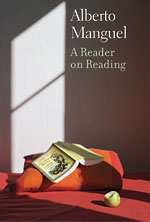Reader in Wonderland
Alberto Manguel offers a brilliant new collection of essays on modern reading By Rebecca Rego Barry
A Reader on Reading
Alberto Manguel; Yale University Press; 320 pages; cloth-bound hardcover; $27.50
Why Wonderland? For those who have followed Alberto Manguel’s work—from A Dictionary of Imaginary Places to A History of Reading to Into the Looking-Glass Wood and The Library at Night—Manguel’s fascination with language is well known. Each essay in this volume opens with a quote from one of Lewis Carroll’s playful novels, which acts as a springboard to discuss the art and craft of reading. He writes in the preface, “What remains invariable is the pleasure of reading, of holding a book in my hands and suddenly feeling that peculiar sense of wonder, recognition, chill, or warmth that for no discernible reason a certain string of words sometimes evokes.”
There are 39 essays in this collection, all exploring various pieces of the experiences of readers and writers. There’s a superb little essay called “The Secret Sharer” on the role of the editor in modern publishing, questioning why North American editors are so much more interventionist than, say, their European counterparts. Manguel, also an accomplished translator, writes on the art of translation and its association to censorship. There are also a few touching essays about Borges, to whom Manguel read as a young man, and several that reveal his feelings about Buenos Aires, where he came of age during massive political unrest.
One of the many wonders of this volume is that Manguel doesn’t give short shrift to any of his topics. His essays have depth, even when they only span two or three pages, such as two of the simpler pieces in the book, “Notes Toward a Definition of the Ideal Reader” and “Notes Toward a Definition of the Ideal Library.” Of the former, he writes, “Ideal readers never count their books.” Of the latter, “The ideal library suggests one continuous text with no discernable beginning and no foreseeable end.”
“How Pinocchio Learned to Read” is about “learning to read,” not in the scholastic sense, but instead by what he terms “Humpty Dumpty’s method,” in which a reader engages with the text on his or her own terms. He suggests that modern readers are trained exclusively for the workforce with its insistence on faster technology and quicker results. He laments, “It is relatively easy to be superficially literate, to follow a sitcom, to understand an advertising joke, to read a political slogan, to use a computer. But to go further and deeper … we need to learn to read in other ways, differently.” Otherwise, we comprehend about as well as wooden puppets.
Along the same lines, “Saint Augustine’s Computer” examines the difference between reading a book and reading a screen full of words. Although he admits many readers may be Luddites at heart, he neither fears the change nor accepts the idea that book culture will disappear.
But to focus too much attention on these two essays seems unfair; this is not yet another book about the clash between books and technology. “The Library At Home,” originally published in the New York Times, briefly and lovingly describes Manguel’s own 30,000-volume library—a “multi-layered autobiography”—installed in an ancient French barn. In it, he proudly asserts, “shiny young Penguins sit happily side by side with severe-looking leather-bound patriarchs.” And his essay, “A Brief History of the Page,” is one of those stand-out pieces that beguiles the reader with its peculiar topic and fine phrasing.
While some of the essays in A Reader on Reading were previously published, many (like this last one) were lectures or conference papers that would have escaped our notice entirely if not for this book, for which book lovers should feel very grateful.








